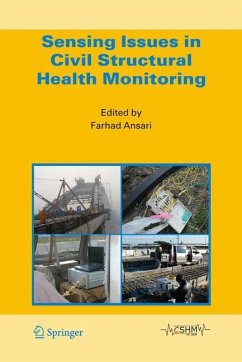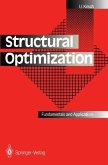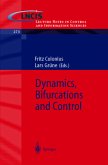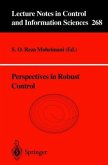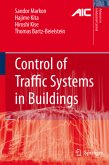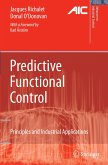- Gebundenes Buch
- Merkliste
- Auf die Merkliste
- Bewerten Bewerten
- Teilen
- Produkt teilen
- Produkterinnerung
- Produkterinnerung
Civil infrastructure systems are generally the most expensive assets in any country, and these systems are deteriorating at an alarming rate. In addition, these systems have a long service life in comparison to most other commercial products. As well, the introduction of intelligent materials and innovative design approaches in these systems is painfully slow due to heavy relianceon traditional construction and maintenance practices, and the conservative nature of design codes. Feedback on the "state of the health" of constructed systems is practically nonexistent. In the quest for lighter,…mehr
Andere Kunden interessierten sich auch für
![Structural Optimization Structural Optimization]() Uri KirschStructural Optimization75,99 €
Uri KirschStructural Optimization75,99 €![Dynamics, Bifurcations and Control Dynamics, Bifurcations and Control]() Fritz Colonius / Lars Grüne (eds.)Dynamics, Bifurcations and Control116,99 €
Fritz Colonius / Lars Grüne (eds.)Dynamics, Bifurcations and Control116,99 €![Networked Embedded Sensing and Control Networked Embedded Sensing and Control]() Panos J. Antsaklis / Paulo Tabuada (eds.)Networked Embedded Sensing and Control154,99 €
Panos J. Antsaklis / Paulo Tabuada (eds.)Networked Embedded Sensing and Control154,99 €![Perspectives in Robust Control Perspectives in Robust Control]() Reza Moheimani (ed.)Perspectives in Robust Control116,99 €
Reza Moheimani (ed.)Perspectives in Robust Control116,99 €![Control of Traffic Systems in Buildings Control of Traffic Systems in Buildings]() Sandor A. MarkonControl of Traffic Systems in Buildings74,99 €
Sandor A. MarkonControl of Traffic Systems in Buildings74,99 €![Shop Floor Control Systems Shop Floor Control Systems]() A. BauerShop Floor Control Systems77,99 €
A. BauerShop Floor Control Systems77,99 €![Predictive Functional Control Predictive Functional Control]() Jacques RichaletPredictive Functional Control74,99 €
Jacques RichaletPredictive Functional Control74,99 €-
-
-
Civil infrastructure systems are generally the most expensive assets in any country, and these systems are deteriorating at an alarming rate. In addition, these systems have a long service life in comparison to most other commercial products. As well, the introduction of intelligent materials and innovative design approaches in these systems is painfully slow due to heavy relianceon traditional construction and maintenance practices, and the conservative nature of design codes. Feedback on the "state of the health" of constructed systems is practically nonexistent. In the quest for lighter, stronger and corrosion-resistant structures, the replacement of ferrous materials by high-strength fibrous ones is being actively pursued in several countries around the world, both with respect to the design of new structures as well as for the rehabilitation and strengthening of existing ones. In North America, active research in the design of new highway bridges is focused on a number of specialty areas, including the replacement of steel reinforcing bars in concrete deck slabs by randomly distributed low-modulus fibers, and the replacement of steel prestressing cables for concrete components by tendons comprising super-strong fibers. Research is also being conducted on using FRPs to repair and strengthen existing structures.
Produktdetails
- Produktdetails
- Verlag: Springer / Springer Netherlands
- 2005
- Seitenzahl: 548
- Erscheinungstermin: 14. Juli 2005
- Englisch
- Abmessung: 241mm x 160mm x 34mm
- Gewicht: 980g
- ISBN-13: 9781402036606
- ISBN-10: 1402036604
- Artikelnr.: 14842271
- Verlag: Springer / Springer Netherlands
- 2005
- Seitenzahl: 548
- Erscheinungstermin: 14. Juli 2005
- Englisch
- Abmessung: 241mm x 160mm x 34mm
- Gewicht: 980g
- ISBN-13: 9781402036606
- ISBN-10: 1402036604
- Artikelnr.: 14842271
Farhad Ansari, University of Illinois, Chicago, USA
Global Perspectives on Structural Health Monitoring of Civil Structures.- Are Civil Structural Engineers "Risk Averse"? Can Civionics Help?.- Monitoring Technologies for Maintenance and Management of Urban Highways in Japan.- The Role of Sensing and Measurement in Achieving FHWA'S Strategic Vision for Highway Infrastructure.- Recent Development of Bridge Health Monitoring System in Korea.- A Strategy to Implement Structural Health Monitoring on Bridges.- Sensors - not Just for Research Anymore.- Investigation of the Dynamic Properties of the Brooklyn Bridge.- Monitoring Issues in Ancient and Modern Structures.- Distributed Sensing Technologies for Monitoring FRP-Strengthened Structures.- Monitoring and Response of CFRP Prestressed Concrete Bridge.- Monitoring and Response of CFRP Prestressed Concrete Bridge.- Design of Temporary and Permanent Arrays to Assess Dynamics Parameters in Historical and Monumental Buildings.- FRP-strengthened Structures: Monitoring Issues from Québec Applications.- Structural and Material Health Monitoring of Historical Objects.- Sensing of Structural Parameters and Extreme Events.- Internal and External Sensing for Post-Earthquake Evaluation of Bridges.- Application of EM Stress Sensors in Large Steel Cables.- Enhancing Durability of Structures by Monitoring Strain and Cracking Behavior.- Development of an Earthquake Damage Detection System for Bridge Structures.- Determination of Rebar Forces Based on the Exterior Crack Opening Displacement Measurement of Reinforced Concrete.- Monitoring System Based on Optical Fiber Sensing Technology for Tunnel Structures and Other Infrastructure.- Development of FBG Sensors for Structural Health Monitoring in Civil Infrastructures.- Smart Sensors, Imaging and NDT of Civil Structures.- Monitoringof a Smart Concrete Beam.- Fiber Optic Nerve Systems with Optical Correlation Domain Technique for Smart Structures and Smart Materials.- Use of Active Sensors for Health Monitoring of Transportation Infrastructure.- Health Monitoring of Concrete Structures Using Self-Diagnosis Materials.- Application of Image Analysis to Steel Structural Engineering.- Shape Memory Alloy-Based Smart Civil Structures with Self-Sensing and Repairing Capabilities.- Smart Sensors and Integrated Shm System for Offshore Structures.- Sensor System Design, Data Quality, Processing, and Interpretation.- Design Considerations for Sensing Systems to Ensure Data Quality.- Practical Implementations of Intelligent Health Monitoring Systems in Hit.- Health Monitoring, Damage Prognosis and Service-Life Prediction - Issues Related to Implementation.- Adaptive Event Detection for Shm System Monitoring.- A Note on Interpretation of Shm Data for Bridges.- Sensor and Instrumentation Performance and Reliability.- Instrumentation Performance During Long-Term Bridge Monitoring.- Stability and Reliability of Fiberoptic Measurement Systems - Basic Conditions for Successful Long-Term Structural Health Monitoring.- Instrumentation of the Indoor Cable Stayed Bridge at Empa.- Structural Health Monitoring Systems for Bridge Decks and Rehabilitated Precast Prestress Concrete Beams.- CFRP Strengthening and Monitoring of a Box Girder Bridge.- Sensors and Condition Evaluation for Bridge Health Monitoring Using Operating Vehicle Loading.- Measuring Instruments for Optical Fiber Sensing.- Implementation of Long Gauge Fiber Optic Sensor Arrays in Civil Structures.- Fiber Optic Sensors Principles.- Absolute Deformation Measurement Using Fiber-Optic White Light Interferometer with Two Broad-Band Sources.- InteractionModel Between Fiber Optic Ultrasonic Sensor and Matrix Materials.- Birefringence and Transverse Strain Sensitivity in Bragg Grating Sensors.- A New Fiber-Optic Acoustic/Vibration Sensor - Characteristics and Application to Civil Structural Health Monitoring.- Embedded Crack Tip Opening Displacement Sensor for Concrete.- Loop Topology Based White Light Interferometric Fiber Optic Sensors Network.- Long Term Health Monitoring of Civil Structures.- Monitoring Results of A Self-Anchored Suspension Bridge.- Long-Term Monitoring of a Hybrid Cable-Stayed Bridge.- Structural Health Monitoring System Applications in Japan.- Long-Term Monitoring Operation of the Test-Road in Korea Highway Corporation(KHC).- Pipeline Buckling Detection by the Distributed Brillouin Sensor.
Global Perspectives on Structural Health Monitoring of Civil Structures.- Are Civil Structural Engineers "Risk Averse"? Can Civionics Help?.- Monitoring Technologies for Maintenance and Management of Urban Highways in Japan.- The Role of Sensing and Measurement in Achieving FHWA'S Strategic Vision for Highway Infrastructure.- Recent Development of Bridge Health Monitoring System in Korea.- A Strategy to Implement Structural Health Monitoring on Bridges.- Sensors - not Just for Research Anymore.- Investigation of the Dynamic Properties of the Brooklyn Bridge.- Monitoring Issues in Ancient and Modern Structures.- Distributed Sensing Technologies for Monitoring FRP-Strengthened Structures.- Monitoring and Response of CFRP Prestressed Concrete Bridge.- Monitoring and Response of CFRP Prestressed Concrete Bridge.- Design of Temporary and Permanent Arrays to Assess Dynamics Parameters in Historical and Monumental Buildings.- FRP-strengthened Structures: Monitoring Issues from Québec Applications.- Structural and Material Health Monitoring of Historical Objects.- Sensing of Structural Parameters and Extreme Events.- Internal and External Sensing for Post-Earthquake Evaluation of Bridges.- Application of EM Stress Sensors in Large Steel Cables.- Enhancing Durability of Structures by Monitoring Strain and Cracking Behavior.- Development of an Earthquake Damage Detection System for Bridge Structures.- Determination of Rebar Forces Based on the Exterior Crack Opening Displacement Measurement of Reinforced Concrete.- Monitoring System Based on Optical Fiber Sensing Technology for Tunnel Structures and Other Infrastructure.- Development of FBG Sensors for Structural Health Monitoring in Civil Infrastructures.- Smart Sensors, Imaging and NDT of Civil Structures.- Monitoringof a Smart Concrete Beam.- Fiber Optic Nerve Systems with Optical Correlation Domain Technique for Smart Structures and Smart Materials.- Use of Active Sensors for Health Monitoring of Transportation Infrastructure.- Health Monitoring of Concrete Structures Using Self-Diagnosis Materials.- Application of Image Analysis to Steel Structural Engineering.- Shape Memory Alloy-Based Smart Civil Structures with Self-Sensing and Repairing Capabilities.- Smart Sensors and Integrated Shm System for Offshore Structures.- Sensor System Design, Data Quality, Processing, and Interpretation.- Design Considerations for Sensing Systems to Ensure Data Quality.- Practical Implementations of Intelligent Health Monitoring Systems in Hit.- Health Monitoring, Damage Prognosis and Service-Life Prediction - Issues Related to Implementation.- Adaptive Event Detection for Shm System Monitoring.- A Note on Interpretation of Shm Data for Bridges.- Sensor and Instrumentation Performance and Reliability.- Instrumentation Performance During Long-Term Bridge Monitoring.- Stability and Reliability of Fiberoptic Measurement Systems - Basic Conditions for Successful Long-Term Structural Health Monitoring.- Instrumentation of the Indoor Cable Stayed Bridge at Empa.- Structural Health Monitoring Systems for Bridge Decks and Rehabilitated Precast Prestress Concrete Beams.- CFRP Strengthening and Monitoring of a Box Girder Bridge.- Sensors and Condition Evaluation for Bridge Health Monitoring Using Operating Vehicle Loading.- Measuring Instruments for Optical Fiber Sensing.- Implementation of Long Gauge Fiber Optic Sensor Arrays in Civil Structures.- Fiber Optic Sensors Principles.- Absolute Deformation Measurement Using Fiber-Optic White Light Interferometer with Two Broad-Band Sources.- InteractionModel Between Fiber Optic Ultrasonic Sensor and Matrix Materials.- Birefringence and Transverse Strain Sensitivity in Bragg Grating Sensors.- A New Fiber-Optic Acoustic/Vibration Sensor - Characteristics and Application to Civil Structural Health Monitoring.- Embedded Crack Tip Opening Displacement Sensor for Concrete.- Loop Topology Based White Light Interferometric Fiber Optic Sensors Network.- Long Term Health Monitoring of Civil Structures.- Monitoring Results of A Self-Anchored Suspension Bridge.- Long-Term Monitoring of a Hybrid Cable-Stayed Bridge.- Structural Health Monitoring System Applications in Japan.- Long-Term Monitoring Operation of the Test-Road in Korea Highway Corporation(KHC).- Pipeline Buckling Detection by the Distributed Brillouin Sensor.

